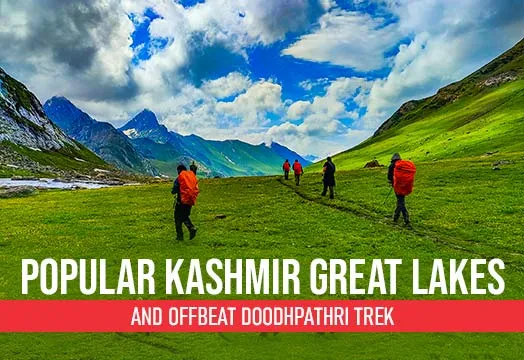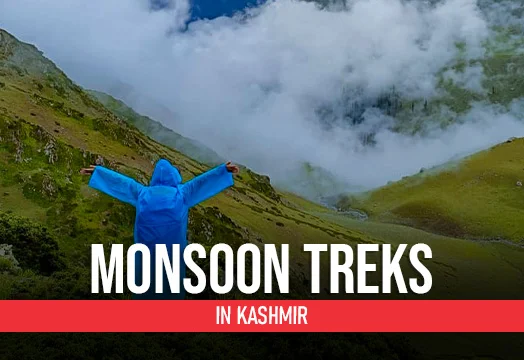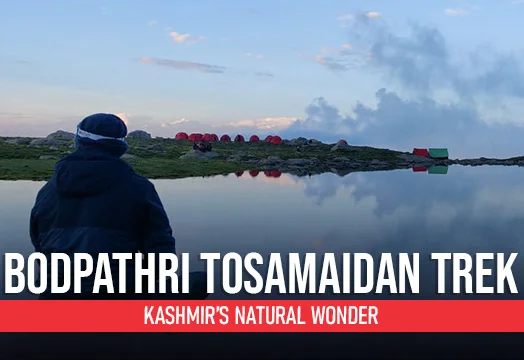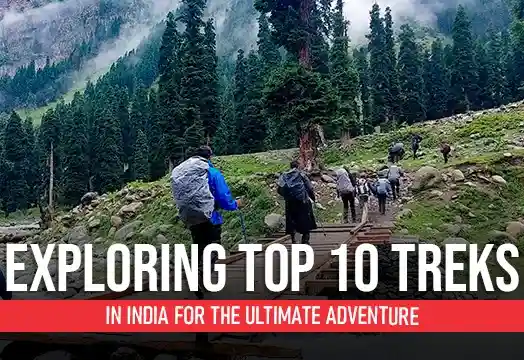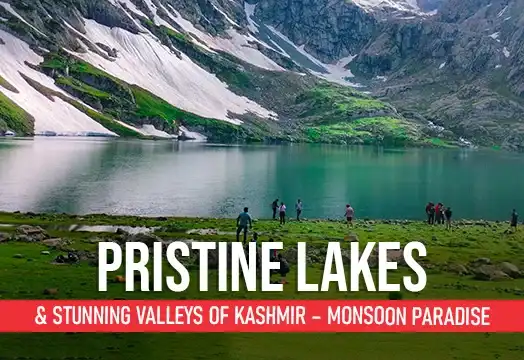Doodhpathri Trek

Region
Kashmir | India

Duration
7 Days

Max Altitude
13060 Ft.

Trekking Km
49 KM

Grade
Moderate to Difficult
Get in Touch with Our Trek Expert
91 7302321133 info@trekthehimalayas.comMonday - Saturday: 10 AM to 09.30 PM (GMT +5:30)
Sunday: 10 AM to 05.30 PM (GMT +5:30)
16800 /Person
- July-2026
- August-2026
- 5% GST will be applicable on Trek Cost and Add-ons
- Services Srinagar to Srinagar | Including Transport.
- Meeting Point( Pickup/ Drop Point ): Nishat Garden Near the Parking Area.
- Reporting Time: 12:00 pm
- Drop Time: 6:30 pm to 7:30 pm (Timings are subject to change based on weather and road conditions).
- Please reach Srinagar a day before to avoid any delays.
Add-ons
Insurance 280
- Insurance is mandatory.
- It is available for Indian citizens only.
- Non-Indians have to take insurance on their own.
- If you already have the high altitude trekking insurance, email for a refund after booking.
- The cancellation policy will be implemented in accordance with the trek cancellation policy.
- For more details about insuranceclick here
- + 5% GST will be applicable
Offload 1800
- Backpack offload is optional.
- Choose add-ons during booking. If missed, log in and add them later.
- Book off-load at least 10 days before the trek.
- For offline bookings at the base camp, a convenience fee of Rs. 2000 applies.
- Cancellations made before the trip date will receive a full refund.
- + 5% GST will be applicable
Get in Touch with Our Trek Expert
91 7302321133info@trekthehimalayas.com
Monday - Saturday: 10 AM to 06 PM (GMT +5:30)
Important Advisory Note for Jammu and Kashmir Trekkers
Jammu and Kashmir stands at the forefront of the most beautiful states of India. Its charm is so overpowering that its landscapes seem an enhanced version of its counterparts in other states.
However, the state is linked to uncertainty because of security issues and political compulsions. So in effect to government decisions, we don’t always receive permits for our Kashmir treks. Or sometimes the government has to call off the civilian movements due to potential uncertainty, and we have to abide by the decision.
In case any such emergency arises, we have clearly laid down policy regarding this development:
- If the government issues a “no permission” advisory by April 30, 2026, we will refund your full trek fee. However, if the treks are running as per schedule after this date, the usual trek cancellation policy will be applied.
- Make sure to choose refundable flight options. It will greatly help you reschedule or cancel your travel without incurring any financial loss. Also, to be on a safer side, book your tickets after April, once you are better informed about the state of affairs in J&K.
- For trekkers from Southern, Western, and Eastern regions of India, it is well-advised to book a flight to Delhi. Here you will get more options if you want to opt for other Himalayan destinations, just in case. It is always better to keep 2 to 3 buffer days in your travel schedule.
Overview
Trek Name: Doodhpathri Trek
Days: 7
Adventure Type: Trekking
Base Camp: Doodhpathri
Season:Monsoon |
Month:July | August |
Country: India
Altitude: 13060 Ft.
Grade: Moderate to Difficult
Rail Head: Jammu
Stay: Camping (Twin sharing) & Hotel/Guesthouse
Food: Meals while on trek & at Hotel/Guesthouse (Veg & Eggs)
Location: Kashmir
Distance: 49 Km.
Trail Type: Cross over trail | Start in one valley, traverse the pass, and ends in another valley.
AirPort: Srinagar (sheikh ul-alam international)
Highlights:
- 5% GST will be applicable on Trek Cost and Add-ons
- Services Srinagar to Srinagar | Including Transport.
- Meeting Point( Pickup/ Drop Point ): Nishat Garden Near the Parking Area.
- Reporting Time: 12:00 pm
- Drop Time: 6:30 pm to 7:30 pm (Timings are subject to change based on weather and road conditions).
- Please reach Srinagar a day before to avoid any delays.
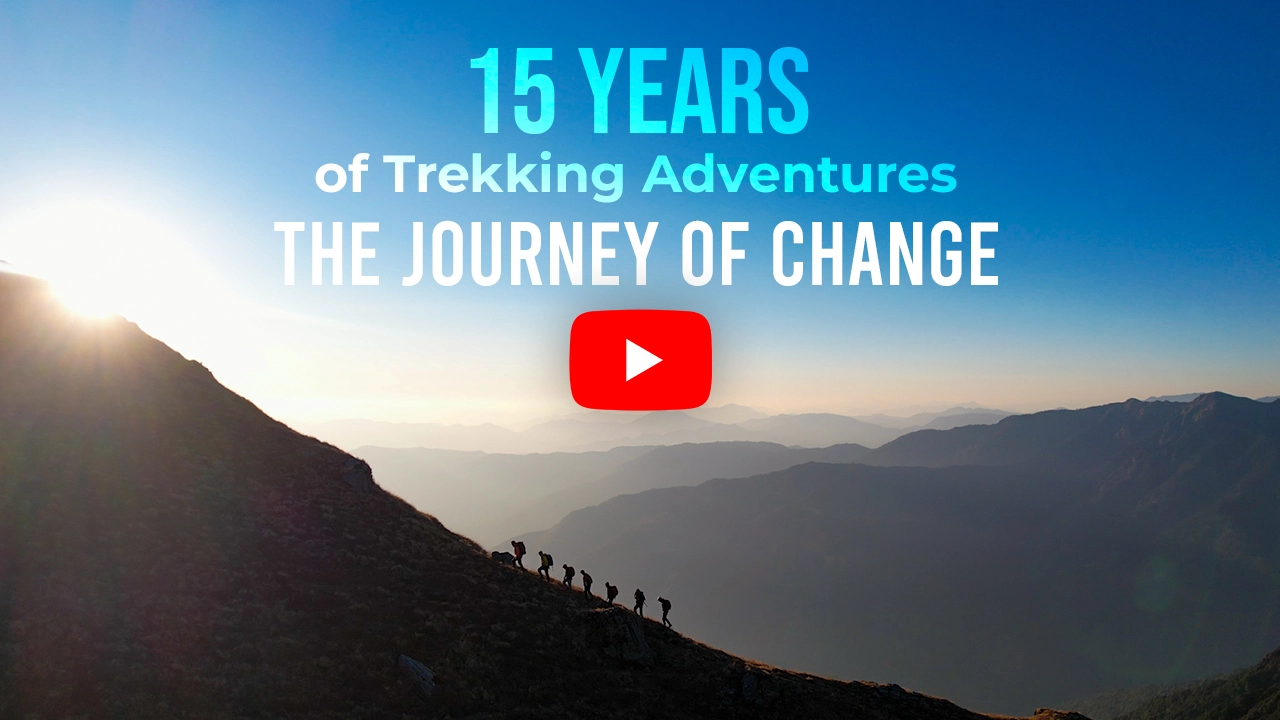
Why is Doodhpathri Trek a Must-Do Trek?
While Kashmir Great Lakes and Tarsar Marsar are two popular treks in Kashmir, not many people know about the wonderful Doodhpathri Trek. It is one of the lesser-known destinations in Kashmir that doesn’t receive much tourism but showcases immense natural beauty and plenty of peace and tranquility. Located about 55 km away from Srinagar, this offbeat trek is a great choice if you want to experience the raw and seemingly untouched beauty of Kashmir.
Kashmir is known for its beautiful meadows, and the Doodhpathri Trek is undoubtedly one of the best scenic splendours of Kashmir. Lying under the shadows of the Pir Panjal Range and the Shailganga River cutting across the valley, the Bodhpathri Trek is full of beauty and peacefulness. The trail follows this beautiful River to its source near the Ashtar Glacier, with lush carpets of undulating green as far as eyes can see.
The Doodhpathri Trek lets you experience 7 wonderful lakes, which are so beautiful that they will completely enchant you. This region of Kashmir was out of bounds until a couple of years ago and now you have the opportunity to explore the unexplored part of Kashmir – its forests, valleys, meadows, streams, rivers, and lakes.
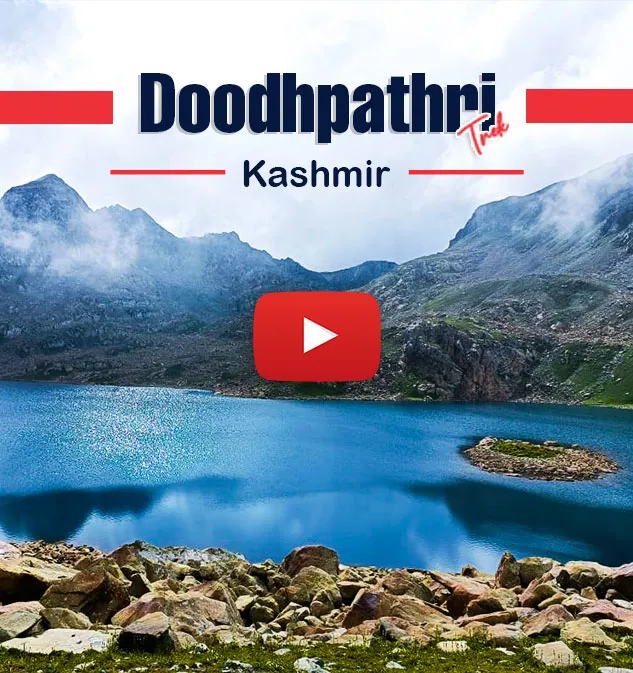
Who Can Participate
- Age Requirement:
- Minimum 14 years
- First-timers are welcome, though prior trekking experience is preferred. Good fitness is a must.
- Fitness Criteria:
- If the trekker wants to carry a backpack then he/she should be able to carry a 10-12 kg backpack. If opt Off-load option then the trekker should be able to carry 3-5 kg backpack.
- If a trekker's BMI is more or less than the normal range (18-27), please consult our Trek Coordinator before booking.
Doodhpathri Trek Itinerary
Drive From Srinagar To Doodhpathri
- Drive distance: 55 km | 2.5 hours.
- Pick-up point: Srinagar.
- Stay in tents (twin sharing).
The trek begins from a place called Doodpathri, which is approximately 55 km from Srinagar. Our representatives will pick you up from Srinagar around 11 am and drive you to the Doodhpathri campsite. Doodpathri is a relatively undiscovered spot for tourists, however, it is a beautiful picnic and camping spot for the locals of Kashmir. The beautiful green meadows of Doodhpathri are quite similar to that of Gulmarg and the river flowing through the meadow gives you the hint of a similar scenery as that of Pahalgam. Tall pine trees loom around the meadows, making the meadows a perfect spot to camp for the night. You might even catch a few shepherds grazing their cattle around the meadows. You can roam around the meadows at your leisure in the evening and after a hearty dinner, retire to your camps for the night.
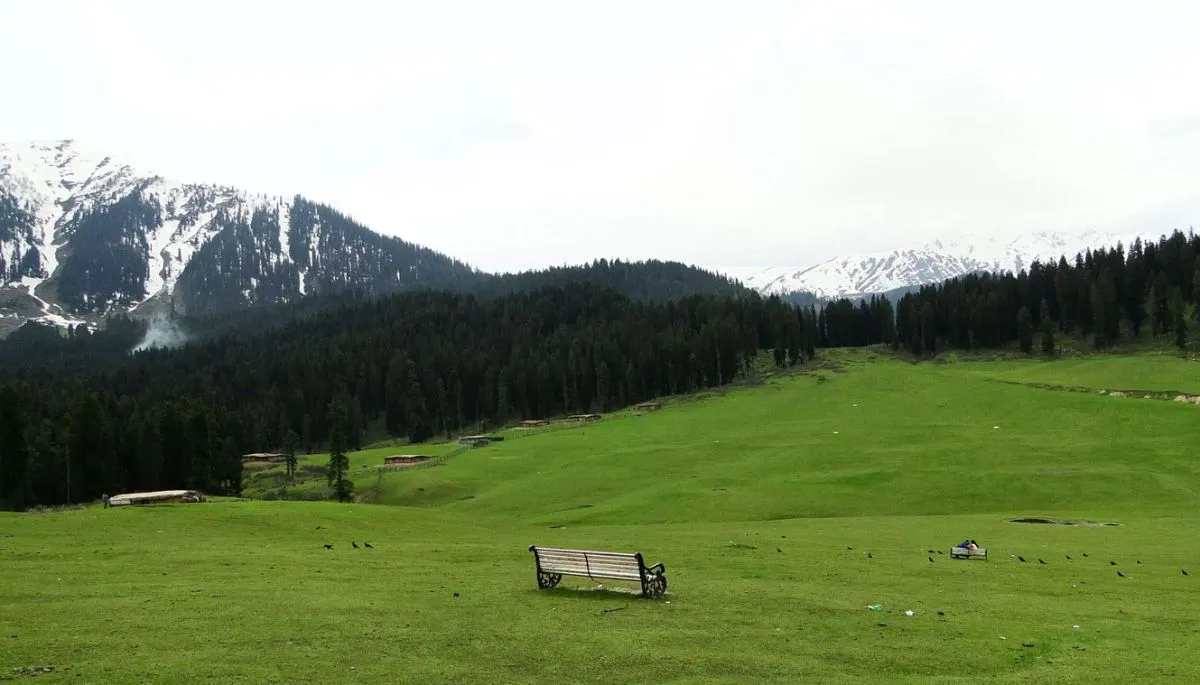
Trek From Doodhpathri To Dishkal
- Trek Distance: 6.5 km | 5-6 hours.
- Altitude gain: 8,900 ft to 10,600 ft.
- Easy-Moderate. A gradual ascent through forests, and meadows.
This is the first trekking day. The gradient of the day is easy. You will start from the Doodhpathri meadow and after crossing the Dhoodhganga river you start ascending the forest cover. The ascend will take around 2 to 3 hours of mild-paced walking. The trail is definite and winds up until you reach above the tree line in the clearing called Diskhal meadow. This is from where the meadows start and will be your company until the end of the trek.
Here at Diskhal meadow, you will be welcomed by a small settlement of Shepherd.
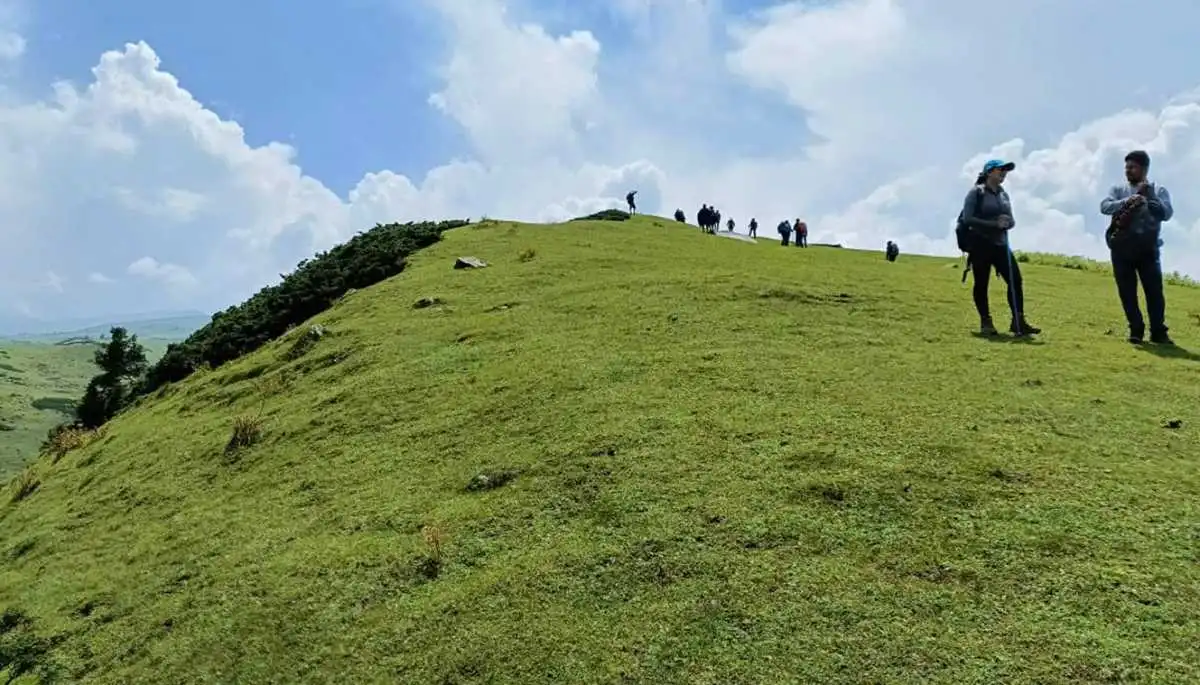
Trek From Diskhal to Ashtar Valley
- Altitude: 11,500 ft.
- Altitude gain: 10,600 ft to 11500 ft.
- Trek distance: 4.5 km | 5 hours.
- Stay in tents (twin sharing).
Ashtar Valley is a rangeland located near the foothills of Mt. Tatakoti. Tatakoti is the highest point of the Pir Panjal Range, which comprises numerous mountain peaks. You may observe the Shali Ganga River flowing through the valley, which flows to Doodhpathri and joins the Doodh Ganga River around Wathoora. The River flows from the Ashtar glacier, which you can see on your right-hand side once you reach the valley. During July, the entire valley is covered in yellow and red blooms. From Ashtar Valley, it’s a level walk of about 2 km before you reach the Ashtar campsite.
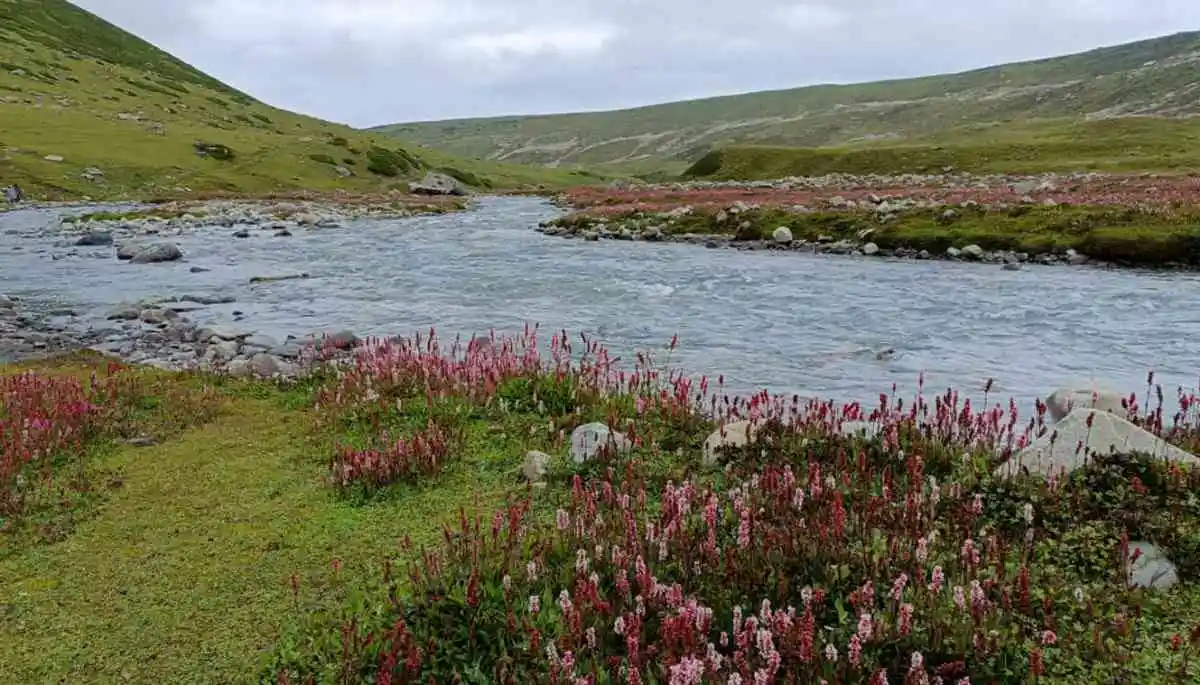
Trek From Ashtar Valley To Gurwansar
- Altitude: 12,500 ft.
- Trek distance: 7 km | 5-6 hours.
- Altitude gain: 11,500 ft to 12,500 ft.
- Moderate. Long gradual Ascents on meadows along with river crossing.
Today is also a fairly easy day of trekking as we trek to Gurwansar Lake. The trek is not difficult per se but what makes it a little tiring is that even though the ascent is gradual but the ascents are very long.
You cross some beautiful meadows and come across some river crossings on your way to Gurwansar Lake. The meadows are surrounded by a dense cover of pine trees, a beautiful sight to behold. This part of the trek is also great to spot a range of birds including the Golden Oriole. You will spot numerous sheep and lambs in the meadows herded by shepherds in the meadows. As you gain altitude, you will get inside cloud covers making for a surreal experience. The more you inch towards the lake, you will begin to see patches of snow depending on the time you are going on the trek.
The Gurwansar Lake sits in the middle of a meadow. In the month of May, the meadow is covered with floral bloom, especially Irish flowers. You can see a stream flowing from the Gurwansar Lake running through the middle of the valley creating a picturesque setting. During the winter months, the lake remains frozen. On the right of the Gurwansar, you can see a panoramic view of the Ashtar Valley that you had just crossed to reach up to the lake. We will camp by the lakeside tonight and in the vicinity of the campsite, you can spot numerous herbs like Saussurea costus, Taraxacum officinale, and Rheum Emodi. Enjoy your stay at this campsite marveling at its beauty of it.
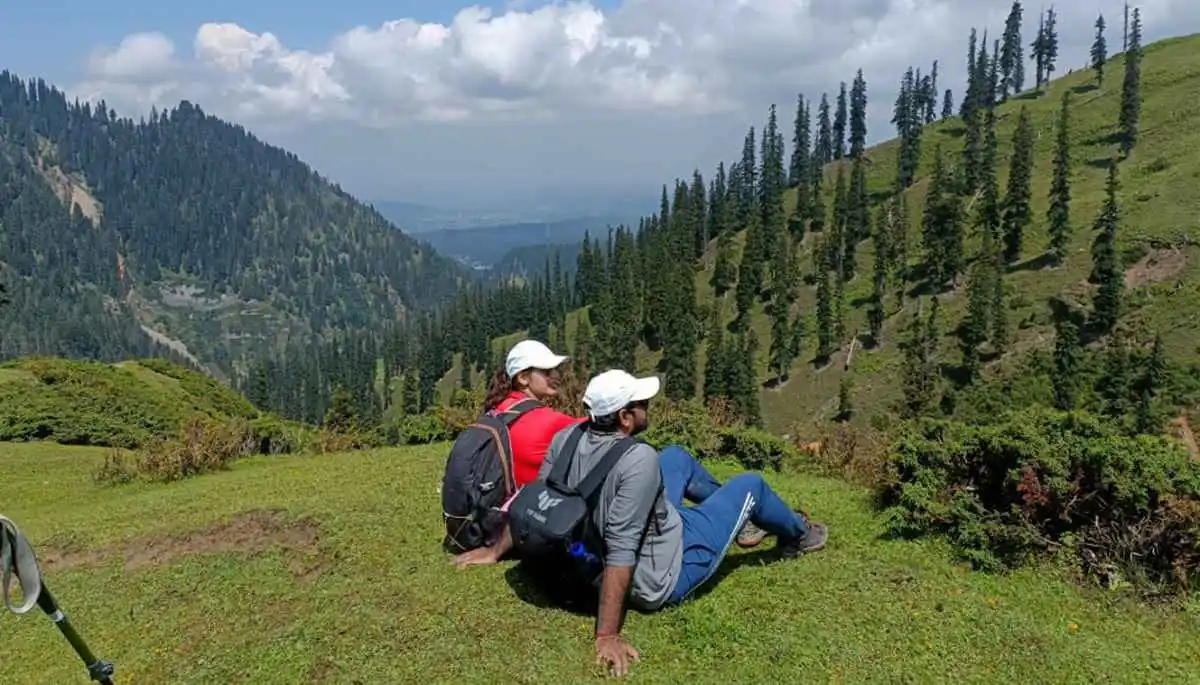
Trek from Gurwansar to Duriem via Pamsar Lake
- Altitude:12,600 ft.
- Trek Distance: 9 km | 7 hrs.
- Altitude gain: 12,500 ft to 12,600 via 13,060 ft.
- Moderate: Difficulty. Long walks, steep ascents through boulder sections.
From Gurwansar campsite, it’s 9 km to Duriem. We will start the day as early as we can, as we have a long distance to cover and the trail is also moderately difficult. Follow the slope towards the west of Gurwansar Lake to head to Duriem via Pamsar Lake. About 20 minutes into walking, you will come across a bouldered section. The boulder section can be quite thrilling and gives an adventurous feel to the trek, although, you definitely need a good deal of fitness to cross this section. Be mindful while you cross the boulders as some of the rocks may be loose and shift disrupting your balance. After a gradual hike through the boulder, Pamsar Lake becomes visible.
It is a huge lake and you may not see it all at once. As you slowly inch closer to the lake, it begins to reveal itself. The beautiful lake is surrounded by a serenity that will soothe your senses. Sit down, and relish a few quiet moments here before you head onwards on your journey towards Duriem.
From the lake, you have to ascend a ridge to reach Duriem. You will ascend through a boulder section to reach a ledge. Continue walking until you reach the top of the ridge and once you reach the top, you can start your descent towards Duriem. Before you arrive at your campsite, you will have a stream crossing, which is quite a refreshing experience after a tiring day. We will pitch our tents after the stream crossing and retire for the night after dinner. Today has been a long day so rest well and recover for the next day’s trek.
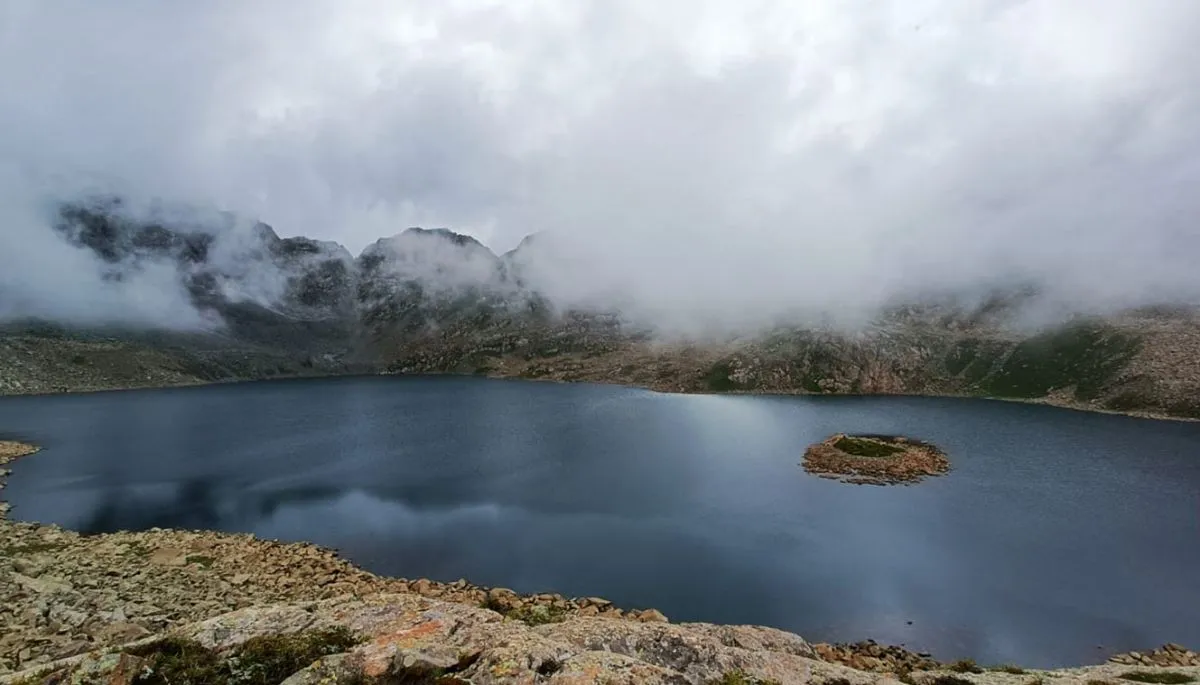
Trek from Duriem to to Gadtar via Bodsar Lake, Trastar Lake, Navkansar I,II & Damamsar Lake
- Altitude:12,500 ft.
- Trek Distance: 10-11 km | 8 hrs.
- Altitude gain and loss: 12,621 ft to 12,545 via 13,000 ft.
- Moderate - Difficulty. Long walks, steep ascents & descents through boulder sections en route to Bodhsar Lake & Navkansar Iake.
Today is going to be a long and interesting day as you spot not one or two but five beautiful lakes. Today also we will start the day early. From the campsite, you will start ascending towards to reach the first lake. After climbing for about 2.5 km, you will reach a point where you will go off the trail. From here you will start trekking towards Bodhsar Lake viewpoint. The viewpoint is about half a kilometer away towards the left. From this viewpoint, you can see the Duriem campsite. Also, keep an eye out for Tratsar Lake, also known as Lokutsar Lake.
After you have spent some time taking in the views and enjoying the beauty of the lakes, you will return back to the point where you started hiking toward Bodhsar Lake. Now you will ascend in the opposite direction through a bouldery section. The ascend becomes steep pretty soon. And continues for about a kilometer until you reach a flat portion of the ridge. This is a picturesque vantage point that unfolds a panoramic view of the lakes in front of you. Spending some time here, you will begin descending from the ridge and after about an hour of descending, you will begin to ascend again until you reach Damamsar Lake. The highest point of the ridge will give a beautiful bird’s eye view of Damamsar Lake as well as Navkansar I and II. This is a wonderful sight. One that stays with you for a long time. The lakes are formations from the snow that has melted from the surrounding mountains. Rejoicing in this captivating view for some time, we will descend all the way to the Gadtar campsite.
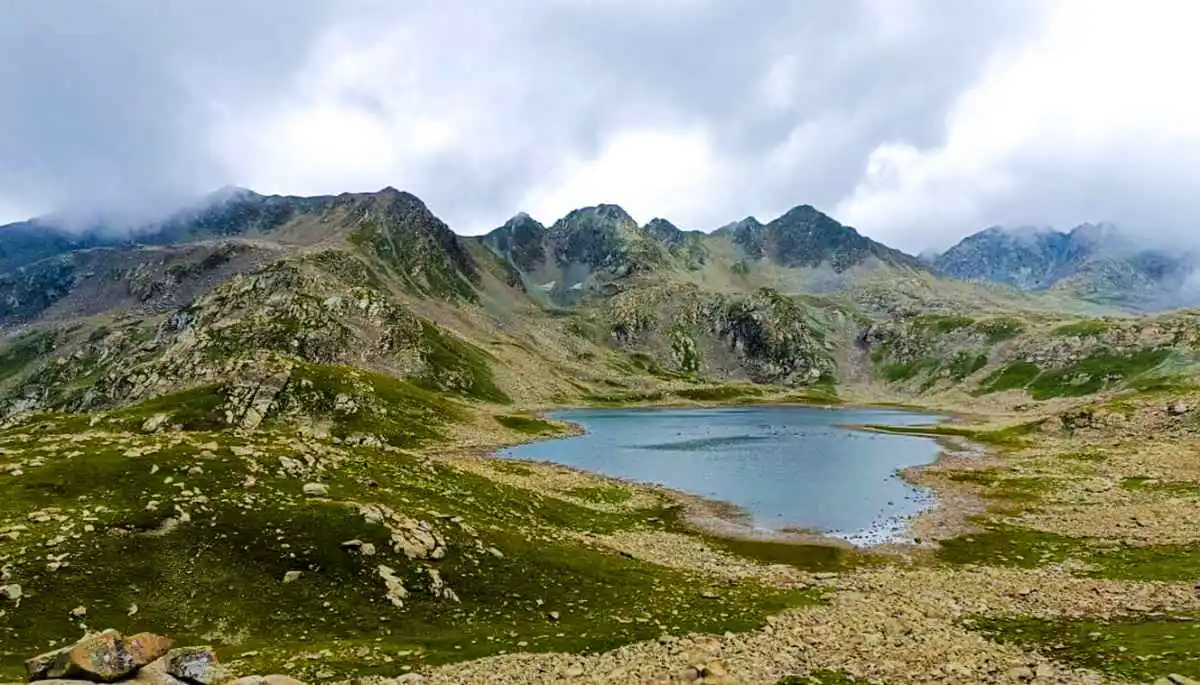
Trek from Gadtar to Tosamaidan. Drive to Srinagar
- Altitude: 10,000 ft.
- Trek Distance: 11 km | 5 to 6 hrs.
- Altitude loss: 12,500 ft to 10,000 ft.
- Drive Distance: 80 km | 3.5 hrs.
- Difficulty: Moderate. Gentle descents along with river crossing on rocks.
Today is the last day of trekking, albeit also the longest. Start early as you have quite a long distance to cover. The trek starts with a wonderful river crossing post which you start ascending to a grassy ledge. There will be a couple of stream crossings today. You will mostly stay around the same altitude as you make ascends and descends until you reach the top of the ridge. Once you reach the top, you will again descend towards the second river crossing of your day followed by a mud trail. This trail also connects to the Tosa Maidan side.
Follow the trail and you will come across a water source and the third stream crossing for the day. This is the last leg of your trek after the river crossing. You can rest for a while if you want. The Tosa Maidan region starts at the end of the descent and it unfolds a very gorgeous vista in front of you, which is a pure treat to the eyes. Now, you will ascend for a short stretch of about 200 meters followed by a U-turn, and then again begin descending towards the diversion. Follow this trail and you will reach the road head soon. Once you reach the road head, mobile networks also start working.
From here, you will be driven to Srinagar, ending this beautiful sojourn in the mountains.
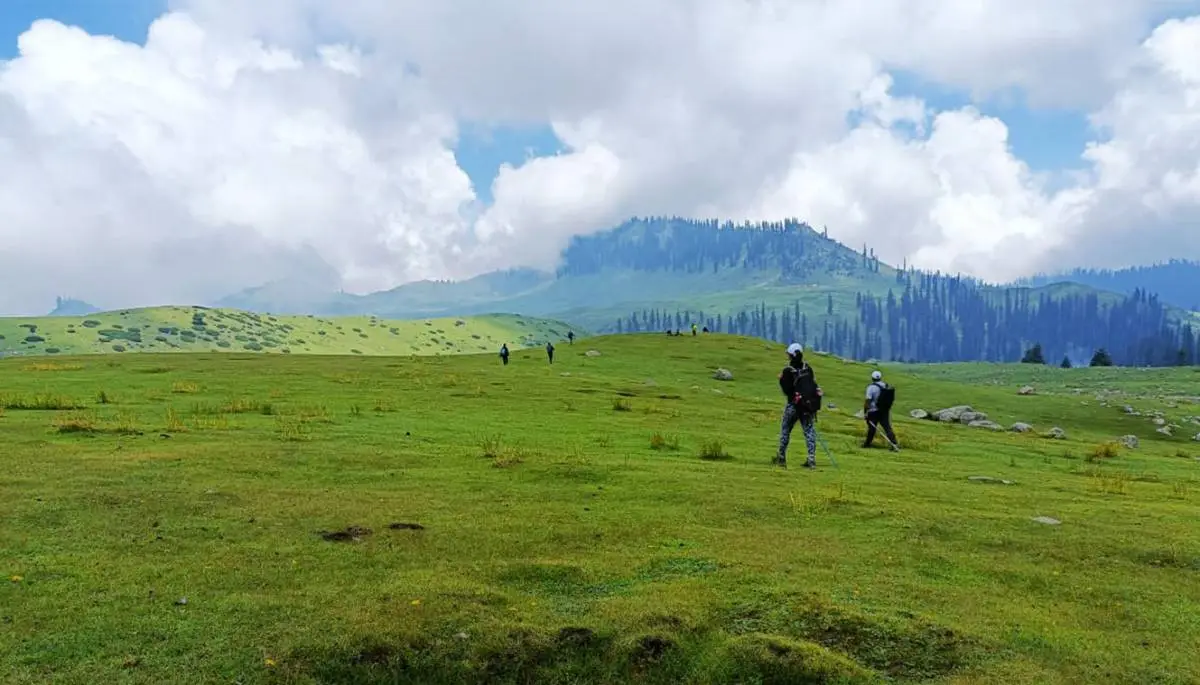
Day-1: Drive From Srinagar To Doodhpathri
- Drive distance: 55 km | 2.5 hours.
- Pick-up point: Srinagar.
Day-2: Trek From Doodhpathri To Dishkal
- Altitude(Dishkal): 10,600ft.
- Trek Distance: 6.5 km | 5-6 hours.
Day-3: Trek From Diskhal to Ashtar Valley
- Altitude: 11,500 ft.
- Trek distance: 4.5 km | 5 hours.
Day-4: Trek From Ashtar Valley To Gurwansar
- Altitude: 12,500 ft.
- Trek distance: 7 km | 5-6 hours.
Day-5: Trek from Gurwansar to Duriem via Pamsar Lake
- Altitude:12,600 ft.
- Trek Distance: 9 km | 7 hrs.
Day-6: Trek from Duriem to to Gadtar via Bodsar Lake, Trastar Lake, Navkansar I,II & Damamsar Lake
- Altitude:12,500 ft.
- Trek Distance: 10-11 km | 8 hrs.
Day-7: Trek from Gadtar to Tosamaidan. Drive to Srinagar
- Altitude: 10,000 ft.
- Trek Distance: 11 km | 5 to 6 hrs.
- Drive Distance: 80 km | 3.5 hrs.
Doodhpathri Trek Graph
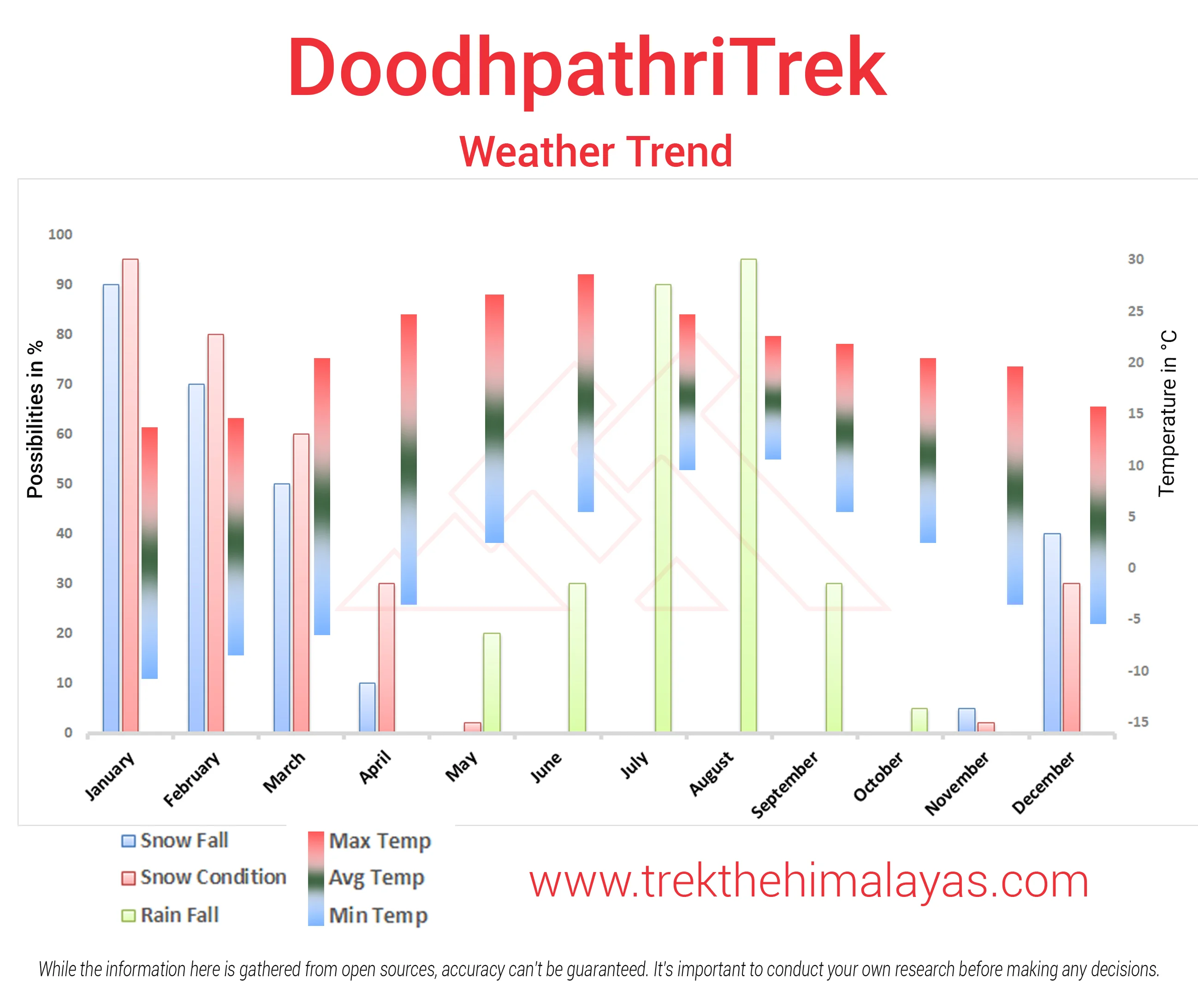
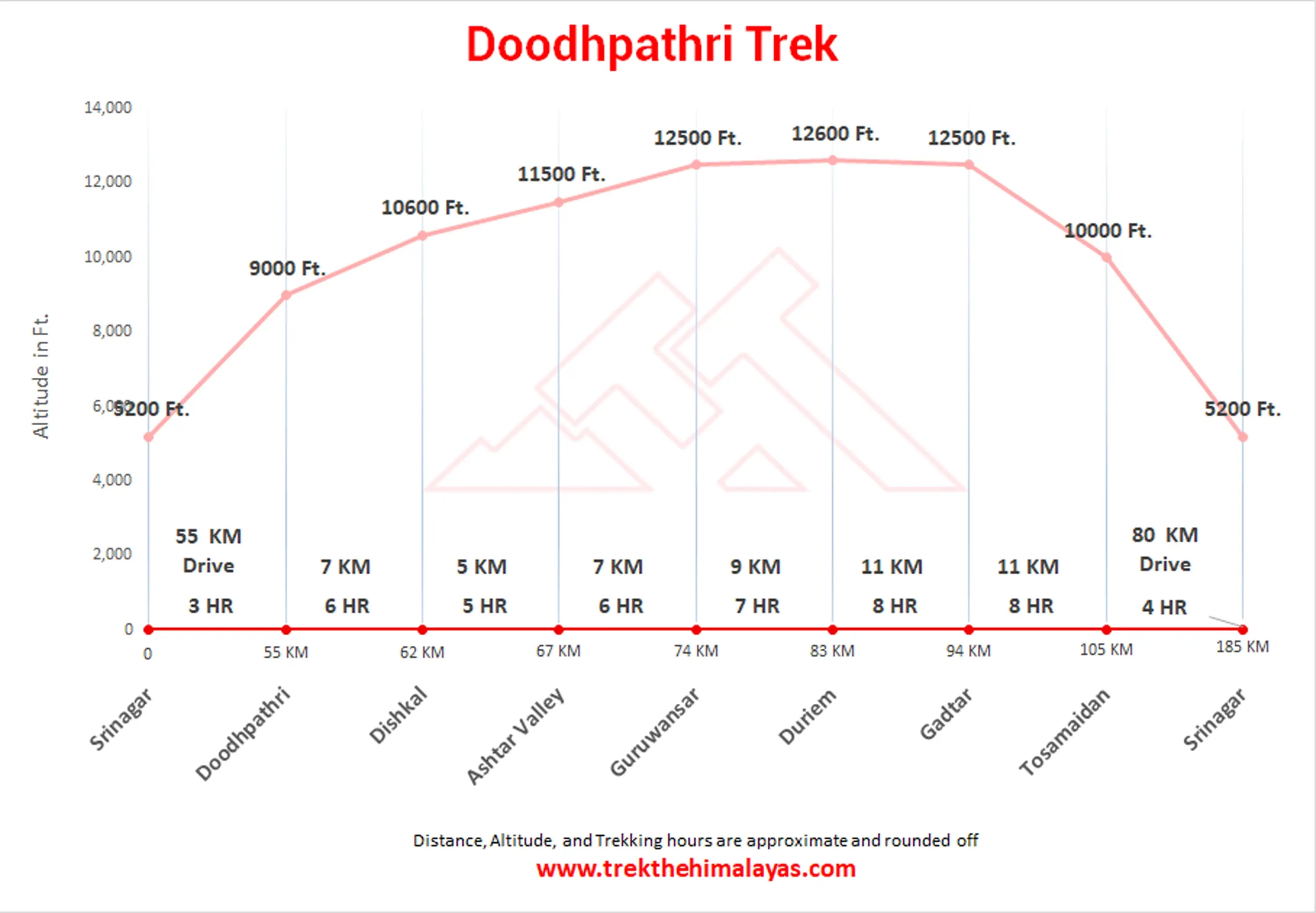
- Pulse rate at rest must be in between (60 to 100 beats per minute).
- Blood Pressure Reading must be in between (DIASTOLIC 75 – 85, SYSTOLIC 100 - 130 mm Hg).
- Respiratory rate at rest must be in between (12 to 20 breaths per minute).
- Should not have Liver and kidney issues.
- Should not have Diabetes Mellitus, Bronchial Asthma, Heart problems, Hypertension, etc.
- No pacemaker implant.
- People with Sinus issues, Epilepsy please contact to trek coordinator before booking the trek.
- If your BMI is not normal, Please contact our Trek coordinator before Trek booking.
Medical & Disclaimer Form (Mandatory Documents) Click here to download Medical & Disclaimer Form
Government employees can avail the benefit of Special Casual Leave (SCL) when they join us for a trekking expedition. As per Pay Commission guidelines, up to 30 days of Special Casual Leave can be availed in a calendar year for trekking or mountaineering expeditions conducted through a registered organisation.
Trek The Himalayas is a registered adventure tour operator with the Indian Mountaineering Foundation (IMF) and the Ministry of Tourism (MoT), making your trek eligible for SCL benefits.
To apply, email us at info@trekthehimalayas at least 20 days before the trek departure date, with the following details:
- Trek name and trek date
- Booking details
- Full name
- Designation
- Department and department address
This benefit is exclusive to Indian Government employees and is applicable only for treks within India.
- Junior trekkers (below 15 years) should have a company of parents/guardians.
- Trekkers between 15 to 18 years can come solo with the disclaimer form signed by parent/guardian.
- Medical & Disclaimer Form (Mandatory Documents) Click here to download Medical & Disclaimer Form
Important Links
- Mandatory Documents to Bring on A Trek Click Here.
- How to pay Add-ons, Submit Medical Forms, and Dietary Preferences Click Here to watch Video
How To Reach
Pick-Up Information
- Pick-up location: Nishat Garden near the Parking Area, Srinagar.
- Once you have reached Srinagar, TTH will manage the rest of your travel arrangements, if you have opted for TTH's pick-up service, you can select this option during the booking process by adding it as an add-on.
- Do reach Srinagar one day before your trek date for a safer side.
- Pick-up Place & Time: Nishat Garden near the Parking Area, Srinagar 12:00 noon.
Options to Reach Srinagar
1. If you are planning to fly to Srinagar which is well connected to all major airports in India, you can reach the Nishat Garden in appx 1 hr via taxi from the airport (approx 20 Km).
2. If you’re coming by train, there are two railway stations.
- Jammu railway station is about 260 km away and takes around 8 hours by bus.
- Udhampur is 200 km away and from there, it is a 6-hour bus journey to Srinagar.
3. If you are taking a bus from Jammu, then you have multiple options to take. There are two gates outside Jammu ISBT. You will get shared cabs from both of these gates.
4. If you are reaching the Railway Station, the share cabs to Srinagar will cost between Rs 700 to Rs 1000.
5. Shared cabs are more from the Jammu ISBT compared to the Railway Station. You can travel from the Railway station to the bus stand. The fare of the bus will be Rs 10. The auto will charge around Rs 80 to 120.
Drop-Off Information
- The designated drop-off point is Nishat Garden near the parking area, Srinagar 6 pm.
- If you have to make any arrangements for further travel from Srinagar, do it the next day.
- TTH offers comfortable transportation through Tempo Traveler, Bolero, or equivalent vehicles. If you wish to upgrade your mode of transportation, please contact your trek coordinator for further assistance.
.webp)
Cost Terms
Inclusion
1. Accommodation (as per the itinerary):
- Camping while on trek (twin sharing).
2. Meals (Veg + Egg):
- All meals while on trek (Veg).
- Day 1 Dinner to Day 7 Pack lunch.
3.Transportation (as per the itinerary):
- Transport from Srinagar to DoodhPathri (Tata Sumo/equivalent non-ac) and return as per the itinerary.
4.Support:
- 1 Versatile base camp manager handles communication and deploys extra manpower in emergencies.
- 1 Mountaineering & First aid qualified professional expedition Leader.
- 1 Experienced high-altitude chef.
- Local experienced guides (Number of guides depending on the group size).
- Enough support staff.
5.Trek equipment:
- Sleeping bag, Sleeping liners (if required), mattresses, and Utensils.
- 3 men all season trekker tent (twin sharing), Kitchen & Dining tent, Toilet tent.
- Camping stool, Walkie talkie.
- Ropes, Helmet, Ice axe, Harness(if required).
- Climbing Boots, Gaiters & Crampon /micro spike (if required).
6.First aid:
- Medical kit, Stretcher, Oxygen cylinder, Blood pressure monitor, Oximeter, Stethoscope.
7. Mules/porters to carry the central luggage.
8. All necessary permits and entry fees, up to the amount charged for Indians.
9. Cloakroom facility not available at the base camp for additional luggage.
10. Trek completion certificate from TTH.
Exclusion
- Insurance (For non-Indian Nationals, NRI or OCI card holders).
- Food during the transit.
- Any kind of personal expenses.
- Mule or porter to carry personal luggage.
- Emergency evacuation, hospitalization charge, etc.
- Any extra costs incurred due to extension/change of the itinerary due to natural calamities roadblocks, vehicle breakdown, etc. factors beyond our control
- Hotel Stay in Srinagar.
- Anything not specifically mentioned under the head Inclusion.
Things can be provided on demand and availability (participant has to pay extra for these things).
1- Satellite phone/set phone - a type of mobile phone that connects via radio links via satellites orbiting the Earth instead of terrestrial cell sites like cell phones. Therefore, they can operate in most geographic locations on the Earth's surface.
Note: Satellite phones are prohibited in Leh-Ladakh, Kashmir, Sikkim due to security concerns related to its proximity to sensitive international borders. Only authorized personnel, like government officials and military, can use them with special permission from the Department of Telecommunications (DoT).
2- Gamow/PAC HAPO Bag (Portable Hyperbaric Bag) - is a unique, portable hyperbaric chamber for the treatment of acute mountain sickness (AMS), also known as altitude sickness.
3- AEDs (Automated External Defibrillators) - are portable life-saving devices designed to treat people experiencing sudden cardiac arrest, a medical condition in which the heart stops beating suddenly and unexpectedly.
Cancellation Terms
To request a cancellation, please email us at info@trekthehimalayas.com using your registered email ID.
Cancellations prior to 25 days from the start of the Trip
Refund Options
- 5% deduction of trek fee
- 100% trek fee cash voucher for any trip till one year
- Transfer your trek (any trek, any date) to your friend
Cancellation between 24 days and 15 days to the start of the Trip
Refund Options
- 30% deduction of trek fee
- 100% trek fee cash voucher for same trip till one year
- 85% trek fee cash voucher for any trip till one year
- Transfer your trek (same trek, any date) to your friend
Cancellation between 14 days and 10 days to the start of the Trip
Refund Options
- 50% deduction of trek fee
- 80% trek fee cash voucher for same trip till one year
- 70% trek fee cash voucher for any trip till one year
- Book the same trek, in the same season, with any other batch
- Transfer your trek (same trek, any date) to your friend
Cancellation less than 9 days to the start of the trek.
Refund Options
- No cash refund
- 20% trek fee cash voucher for the same trip till one year
- 10% trek fee cash voucher for any trip till one year
- Transfer your trek (same trek, same date) to your friend
- To reschedule a trek (same trek only), a 30 % rescheduling fee of the trek cost will apply.
Cancellation Policy (Emergency Cases):
In case of a death in the immediate family (parents, siblings, spouse, children) or if the trekker is hospitalized (min. 48 hours) or suffers a fracture (leg/arm) within a week before the trek, even if canceled a day before:
90% trek fee refund in cash & 10% as a voucher (valid for 1 year, for any India trek).
Valid documents required. We’re here to support you during tough times.
Note:
- Change of trek batch is dependent on the availability of seats in the batch
- In case of transferring a trek to a friend, he/she should satisfy all the mandatory requirements put forward by TTH
- TTH holds the right to change/cancel the policies, without prior notice
Booking and Payments
- The Participant is responsible for verifying the accuracy of all details, including Trip dates and personal documentation, at the time of booking.
- Payments must be made in accordance with the timelines and instructions provided by TTH. Late payments may result in cancellation of booking without refund.
- In the event of a cash refund, only the portion of the payment made in cash shall be eligible for refund in cash. Any booking made using voucher, discounts, promotional codes, or through any non-cash mode of payment shall not be eligible for a cash refund under any circumstances.
- Refunds, if applicable, shall be processed within 15–30 working days of confirmation.
- All add-on bookings are subject to the respective add-on cancellation policy, and refunds will be processed accordingly.
- Voucher Terms
- This is a non-transferable voucher
- The voucher cannot be merged with any other offer of Trek The Himalayas
- The voucher is valid for Trek booked directly with Trek The Himalayas in India
- To avail the voucher please use your register phone number or e-mail id
- All the other Terms of booking a trek with Trek The Himalayas are applicable to the voucher
Itinerary and Modifications
- TTH reserves the right to modify, shorten, or cancel any part of the Trip due to transportation delays, weather, health emergencies, or other unforeseen circumstances including Force Majeure.
Cancellations and Refunds
- No refunds or vouchers, partial or otherwise, shall be provided for voluntary withdrawal, non-utilisation of services, or removal from the Trip.
- If TTH cancels the Trip before arrival at the designated pick-up point due to unforeseen circumstances or Force Majeure, the Participant may choose from:
- An alternate Trip/date.
- A credit voucher valid for one (1) year.
- Transfer to another Trip, with cost differences payable by the Participant.
- If the Trip is abandoned post-arrival at the designated pick-up point, no cash refund or voucher shall be issued. The Trek Again Policy may apply at TTH’s discretion.
- TTH shall not be liable for any associated travel costs such as flights, accommodation, or visa fees.
Force Majeure
- Events beyond its control including but not limited to earthquakes, landslides, strikes, curfews, war, pandemic, government restrictions, heavy rainfall or snowfall, windstorms, road blockages, trail disruption, or withdrawal of permits, TTH shall not be held liable for any cancellation, delay, or service modification caused by Force Majeure.
Trek Essentials
Rent EquipmentPDF Of Trek Essential Download
| Backpack with rain cover | (50 - 60 ltr) with comfortable shoulder straps |
| Day pack with rain cover | 20 - 30 ltr (If off-load opted) |
| Walking stick | Advisable (At least one) |
| Water Bottle / Hydration pack | 2 bottles of one liter each, People who use hydration pack 1 hydration pack and 1 bottle of one liter. |
| Small size tiffin/lunch box | 1 Nos |
| Snacks | Energy bars, dry fruits, electral/ors |
| Personal Medical Kit | Consult your doctor |
| T-Shirt (Synthetic quick dry) | 2 Full & 2 Half sleeves |
| Fleece T-shirt | 1 Nos |
| Wind stopper / Fleece jacket | 1 Nos |
| Windproof Jacket | 1 Nos |
| Down feather / Hollow jacket | 1 Nos |
| Thermal inner (Upper and Lower) | 1 Pair |
| Trek Pant (Synthetic quick dry) | 3 Nos |
| Wind stopper / Fleece Pant | Not required |
| Waterproof gloves | Not required |
| Fleece / woollen gloves | 1 Pair |
| Poncho / waterproof Jacket and pant | 1 Nos |
| Sunscreen | 1 Nos |
| Moisturiser | 1 Nos |
| Chap-stick / Lip balm | 1 Nos |
| Toothbrush and toothpaste | 1 Nos |
| Toilet paper & Wipes | 1 Nos |
| Soap / hand sanitizers | 1 Nos |
| Antibacterial powder | 1 Nos |
| Quick dry towel | 1 Nos |
| Head torch | 1 Nos. (Avoid Hand torch) |
| Sun Cap | Not required |
| Woolen cap | 1 Nos. |
| Balaclava | Not required |
| Buff / Neck-gaiters | 2 Synthetic |
| Sunglasses | UV with dark side cover, People who wear spectacles - (A)- Use contact lenses | (B)- Photo chromatic glasses |
| Trekking shoes | 1 Pair (Water-resistant, high ankle, good grip) |
| Floaters / flip-flops | 1 Pair |
| Cotton socks | 7 pairs |
| Woollen socks | 1 pairs |
| Gaiters | 1 Pair (TTH provides when required) |
| Micro spikes | 1 Pair (TTH provides when required) |
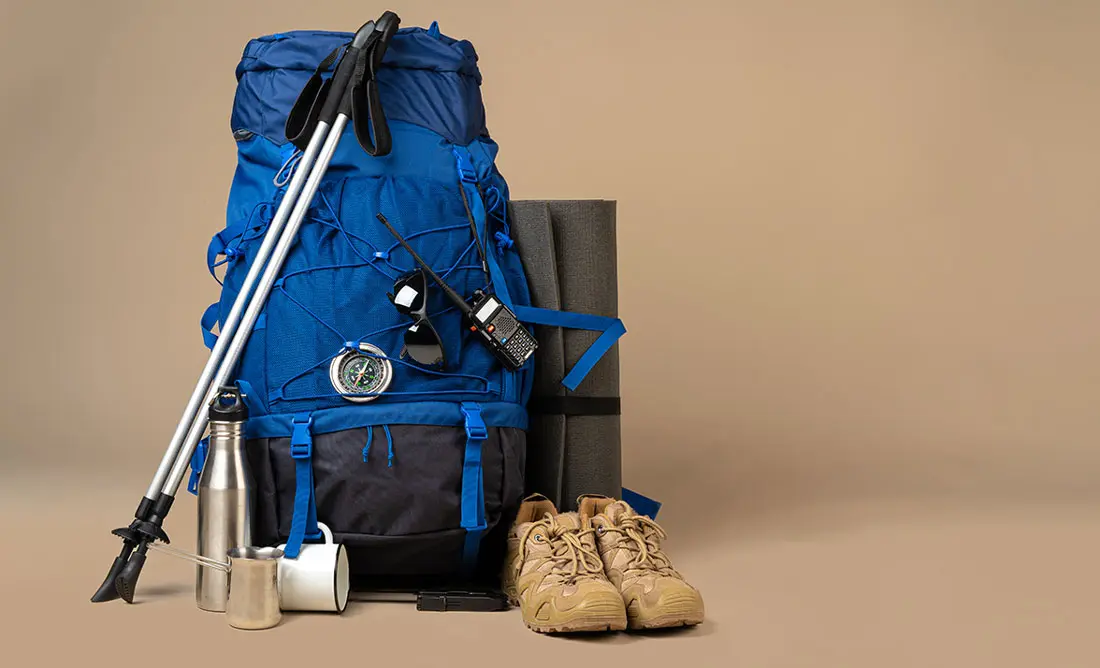
Frequently Asked Questions(FAQ)
To register with TTH, visit our website - www.trekthehimalayas.com and create your account. To create your account you will need to use your email address and fill in all the details, set your unique password and your account is ready to use.
- To book a trek with TTH, you first need to register with us and create an account.
- Choose the trek that you want to do and click on available dates.
- You will land at the login page, fill in the required details.
- Add Participants, choose add-on services click on the Pay now button, choose your preferred payment method, and make the payment. TTH accepts multiple payment options, including credit/debit cards, net banking, and UPI.
- You will receive a confirmation email from TTH with all the necessary details about the trek, including the meeting point, transportation, accommodation, and other important instructions.
- Click Here to watch Video
please send an email to us at info@trekthehimalayas.com or reach out to the numbers provided in the Help and Support section of your Trek Page. We will ensure that your issue is promptly resolved.
To book services such as off-load luggage and transportation, you can find them listed as add-ons. These additional services can be booked at the time of your initial booking. If you miss booking add-ons during the initial reservation, you can log in anytime and easily book 4 days before the departure date add-ons through the platform.
If you have booked the wrong trek or selected the wrong date, don’t worry! You can contact us at +91 9368882322 (Monday to Saturday, 10 AM to 10 PM) or email us at info@trekthehimalayas.com. You can also discuss this with your trek coordinator. Please make sure to inform us at least 10 days before the departure of your trek. Only then can we help you reschedule or arrange another trek for you.
We recommend visiting our "Suggest Me a Trek" page. By filling out the form, our experts will contact you with the best possible trek options based on your preferences and experience level. Alternatively, you can reach out to us via email at info@trekthehimalayas.com or give us a call using the numbers provided on our website for personalized assistance and recommendations.
Family treks differ from regular treks by focusing on ease of difficulty, offering shorter durations for younger participants, Kid-friendly and easily digestible foods, child-friendly activities, maintaining a higher guide ratio for diverse age groups, and implementing additional safety measures for families.
Family Trek with Kids recommendation Only Dayara Bugyal and Chopta Chandrashila Trek.
Minimum age for TTH treks is typically 7 years, though this may vary depending on the specific trek.
Yes, you can take a kids to a high-altitude trek with a parent. Discuss with a trek expert before booking a trek.
- Junior trekkers (below 15 years) should have a company of parents/guardians.
- Trekkers between 15 to 18 years can come solo with the disclaimer form signed by parent/guardian.
- Medical & Disclaimer Form (Mandatory Documents) Click here to download medical and disclaimer form
Physical Fitness: Ensure your child is physically fit. Engage them in regular exercise, outdoor activities, and hikes to build stamina and endurance. Hydration: Emphasize the importance of staying hydrated at high altitudes. Encourage your child to drink water regularly, even if they don't feel thirsty. Proper Nutrition: Provide a well-balanced diet with sufficient carbohydrates for energy and foods rich in iron to prevent altitude sickness. Adequate Sleep: Ensure your child gets enough sleep in the days leading up to the trek. Quality rest is crucial for altitude adaptation. Educate on Altitude Sickness: Teach your child about the symptoms of altitude sickness, such as headache, nausea, and dizziness. Encourage them to communicate any discomfort immediately. Appropriate Clothing and Gear: Dress your child in layers to adjust to changing temperatures. Ensure they have appropriate trekking gear, including sturdy footwear. Positive Mindset: Foster a positive mindset. Encourage your child, and let them know it's okay to take breaks when needed. Medical Check-Up: Schedule a medical check-up before the trek to ensure your child is fit for high-altitude activities. Consult with a healthcare professional about any potential health concerns.
TTH takes special care to provide wholesome and nutritious food for children on treks. Here are some of the foods that are typically served for children:
Breakfast: For breakfast, TTH serves a variety of options like porridge, cornflakes, bread, butter, jam, honey, boiled eggs, omelettes, and pancakes. Children can choose from these options to fuel themselves for the day's trek.
Lunch: For lunch, TTH serves lunch which includes rotis, vegetables, rice, dal, and salad. The rotis are usually made fresh on the trek and are a good source of carbohydrates. The dal and vegetables provide protein and other essential nutrients.
Snacks: TTH provides healthy snacks like fresh fruits, dry fruits, energy bars, cookies, and biscuits to keep the children energized throughout the day.
Dinner: For dinner, TTH serves a hot and wholesome meal which includes soup, rice, dal, vegetables, and a non-vegetarian dish (if requested in advance). Children can also choose from a variety of desserts like custard, jelly, and fruit salad.
Dietary requirements: If a child has any special dietary requirements, TTH can cater to those needs as well. For example, if a child is lactose intolerant or allergic to nuts, the kitchen staff can make arrangements to accommodate those requirements.
Choosing the right trek for a beginner can be a bit overwhelming as there are many factors to consider such as distance, elevation gain, terrain difficulty, weather, and time of year. Here are some tips that can help you choose the right trek for a beginner:
1. Determine fitness level: Assess the fitness level of the beginner to understand their physical capabilities. This will help you select a trek that is challenging but not too difficult.
2. Choose a well-traveled trail: A well-traveled trail will have more amenities such as signposts, water stations, and shelter. It is also safer as there will be other hikers on the trail.
3. Consider the length of the trek: For beginners, it is recommended to start with a shorter trek that can be completed in a day or two. This will help them get acclimatized to trekking and build their confidence.
4. Look for gradual elevation gain: Choose a trek with a gradual elevation gain rather than steep ascents. This will make the trek easier and more enjoyable.
5. Check the weather: Check the weather forecast before selecting a trek. Avoid treks during the monsoon season or winter when the trails can be slippery or dangerous.
6. Research the trail: Read about the trail to get an idea of the terrain, altitude, and difficulty level. This will help you select a trek that is suitable for the beginner.
7. Consult with an expert: If you are unsure about which trek to choose, consult our trek expert Mr. Nitin (+91 70600 59773) between 10 AM to 6 PM (Tuesday - Friday). Mr. Nitin will provide you valuable advice and guidance.
Overall, it is important to choose a trek that is enjoyable, challenging but not too difficult, and suitable for the beginner's fitness level and experience.
It is not recommended for a beginner to choose a difficult Himalayan trek. Trekking in the Himalayas can be physically and mentally challenging, especially if you are not used to the high altitude, steep slopes, and rugged terrain. Choosing a difficult trek without the proper experience, fitness level, and preparation can be dangerous and put you at risk of altitude sickness, injury, and other hazards.
If you are a beginner, it is recommended to start with an easier trek and gradually build up your skills and experience. This will help you understand the challenges of trekking in the Himalayas, and also prepare you physically and mentally for a more difficult trek in the future. It is also important to choose a trek that matches your fitness level, experience, and interest.
There is no specific age limit for a beginner trekker. However, it is important to consider your physical fitness, health condition, and personal interests before embarking on a trek. Trekking in the Himalayas can be physically and mentally demanding, and requires a certain level of physical fitness and endurance.
If you have any pre-existing medical conditions or are above a certain age, it is recommended to consult with a doctor before embarking on a trek. It is also important to listen to your body and take breaks as needed during the trek to prevent exhaustion or injury.
We recommend visiting our "Suggest Me a Trek" page. By filling out the form, our experts will contact you with the best possible trek options based on your preferences and experience level. Alternatively, you can reach out to us via email at info@trekthehimalayas.com or give us a call using the numbers provided on our website for personalized assistance and recommendations.
Yes, you can join the trek. We have fixed departure groups where you can simply book your trek and we will take care of curating a group.
Before you start the trek, it is recommended that you make all the necessary phone calls as during the trek you may or may not receive network coverage, once you come back to the Base Camp, you can reconnect with your family via phone once again. You can share your trek coordinator contact detail with your family members to get the latest updates about your trek batch.
At TTH, we provide wholesome and nutritious meals during the trek. The food is vegetarian and includes a variety of dishes such as rice, dal, vegetables, chapati, paratha, pasta, noodles, and soup. We also offer snacks such as biscuits, and salty, and dry fruits during the trek. Special dietary requirements such as vegan, gluten-free, or Jain food can also be arranged if informed in advance.
If you are allergic to some foods, you need to let us know in advance so that we can make arrangements accordingly.
TTH is a trekking company that prioritizes the safety of all its participants, including women trekkers. We have a comprehensive safety system in place, which includes a dedicated team of experienced and trained trek leaders and support staff who are equipped to handle emergency situations and provide first aid.
TTH also takes specific measures to ensure the safety and comfort of women trekkers. They have a separate tent accommodation for women trekkers, female trek leaders, and support staff. They also provide separate toilet facilities for women and encourage a safe and respectful environment for all trekkers.
Moreover, TTH has a strict policy against any kind of harassment and has a zero-tolerance policy towards such incidents. They have a designated Internal Complaints Committee (ICC) to investigate and address any complaints related to harassment or misconduct. Overall, TTH has a good reputation for safety and responsible trekking practices, and women can feel comfortable and safe while trekking with them.
In case you are the only women in the group, we provide a single sleeping arrangement. Also, during the trek, the trek leader will always remain by your side to provide optimum safety and reassurance.
You can reach out to the trek coordinator to inquire about the number of female trekkers and their respective states who have booked the trek. Please note that the trek coordinator cannot disclose personal details of any trekker. Once you've confirmed your booking, a WhatsApp Group will be created for all the trekkers in your batch. This allows you to connect with fellow trekkers before the trek begins.
While many of our treks are led by female trek leaders, however, it is not possible to know which trek leader is assigned to which group. But nonetheless, whether the trek leader is male or female you can be completely assured of your safety and security with us.
Yes, it is possible to trek with periods. However, it is important to take some extra precautions and preparations to ensure a comfortable and safe trekking experience. Here are some tips that can help you trek during your period:
1. Use menstrual hygiene products that you are comfortable with, such as tampons, pads, or menstrual cups. It is recommended to carry enough supplies for the entire duration of the trek.
2. Pack wet wipes, hand sanitizer, and plastic bags to dispose of used hygiene products.
3. Wear comfortable and breathable clothing that allows for easy movement and reduces friction. Avoid wearing tight or restrictive clothing that can cause discomfort.
4. Carry pain relief medication, such as ibuprofen or acetaminophen, in case of menstrual cramps.
5. Stay hydrated and maintain a balanced diet to support your energy levels and overall health.
6. Take breaks as needed and listen to your body. If you feel uncomfortable or experience any unusual symptoms, seek medical attention immediately. It is also recommended to consult with a doctor before going on a trek during your period, especially if you have a pre-existing medical condition or are taking medication.
By taking necessary precautions and being prepared, you can have a safe and comfortable trekking experience even during your period. We provide proper disposal facilities for sanitary pad disposal during the trek.
We offer three person tents with twin-sharing for optimum comfort. A woman trekker will share a tent with another woman trekker and if you are the only woman in the group, you will be given a single accommodation for your comfort and privacy.
Yes, we do provide gears on rent. You can book it using you TTH account directly.
Mountaineering qualified Experienced and first aid certified Trek Leader, First Aid Certify local guide, Cook, helpers and supporting staff.
People suffering from Bronchitis, Asthma, High blood pressure, Epilepsy (got faints), TB , Heart problem or on higher BMI side are strictly not allowed to go on any Himalayan trek. Apart from this if you had any medical history, please let us know.
No. Alcohol and smoking isn’t allowed while on trek. It is totally misconception that it will keep you warm. Your body need to acclimatize properly and for that eat properly and drink enough water; these things will keep you warm.
Toilet tents provide a convenient solution for answering nature's call in the great outdoors. Dry toilets, in particular, offer a highly sanitary approach. By digging a pit and utilizing mud and a shovel, you can easily cover up your waste. This method ensures cleanliness and hygiene while camping or exploring in the forest.
Remember to pack essential toiletries to complete your outdoor bathroom kit and maintain proper personal hygiene during your adventures. With these practices in place, you can enjoy nature while also respecting it.
Layer Up From Head To Toe
Eat Full Meals, never sleep empty stomach
You can keep warmee (if you’re more susceptible to cold).
Use sleeping bag in right way and don’t leave free space in sleeping bag.
For upper body
– Thermal layer
– T-shirt (full-sleeves)
– Fleece T-shirt (for extreme colds)
– Fleece layer
– Thick Jacket/Down Jacket
– Waterproof or Windproof layer (outermost layer, when it is snowing or raining)
- For Lower Body
– Thermal layer
– Hiking pants (normal) or Winter hiking pants
Based on how warm you feel you can skip any of the above layers. Your outer later should be windproof since it is windy at high altitude.
The idea behind layering is that the more insulation you have the less cold you feel, and instead of wearing a very thick jacket if you wear multiple layers, your body will be better insulated against the cold.
Yes, we provide micro spikes and gaiters, if required.
Mandatory documents: 2 xerox of ID having address (addhar card/driving license), 2 Passport size photographs, hard copy Medical form signed & sealed by doctor, disclaimer form sign by trekker and high altitude insurance.
No. We don’t but we can suggest you good hotel/Stay nearby pick up location.
Yes, trekker must carry 2 water bottles 1 litre each so they can refill it at campsite for drinking and keep themselves hydrate.
You should buy shoes which has these three features –Good grip, Ankle Support and additional water resistant layers. Generally, we advise Quechua Trek 100, MH 500 and MH 100.
No one is forced to go on. There is always enough staff to split the party according to need and regroup later at the camp. Most people have no trouble reaching the highest campsite. If some members decide not to climb the final distance they can wait for the climbers to come back down the same way or take a lateral path to the descent route.
The Doodhpathri Trek is located in Jammu & Kashmir Region of India.
The Doodhpathri trek starts from a place called Doodhpathri and is located 55 km from Srinagar. Doodhpathri is well-connected by roads from Srinagar.
The best time to do the Doodhpathri Trek is during the summer months from June to September. During this time, the weather is pleasant, and the temperatures are mild, making it an ideal time to enjoy the scenic beauty of the area.
The Doodhpathri Trek is a 7-day long trek in Jammu & Kashmir.
Doodhpathri Trek is a moderate grade trek.
The maximum altitude of the Doodhpathri trek is 13,100 ft.
During the Doodhpathri Trek, you will stay in camps at different campsites. We offer twin-sharing tents during the trek.
Trekking in the Himalayas is mostly a hassle-free affair as all the permits and permissions are usually derived by our team. However, you have to bring some essential documents with you that are a must for any Himalayan Trek. The documents include:
1. Medical Disclaimer.
2. Original and printed copies of ID and address proof.
3. "2 passport-sized photographs".
When embarking on the Doodhpathri Trek, it is essential to carry the following items..
1. Trekking boots or shoes: Good quality, comfortable, and sturdy trekking shoes are essential for navigating rocky terrain and steep inclines..
2. Backpack: A good quality backpack with a capacity of 40-50 liters is essential to carry all your gear and supplies..
3. Warm clothes: Temperatures can drop significantly at higher elevations, even during the summer months, so it's essential to carry warm clothes such as a down jacket, fleece jacket, thermal wear, and gloves..
4. Rain gear: The weather can be unpredictable in the mountains, so carrying a waterproof jacket and pants is essential..
5. First aid kit: A basic first aid kit with essential items such as bandages, antiseptic cream, painkillers, and medicines for altitude sickness is crucial..
6. Sun protection: Carry a hat, sunglasses, and sunscreen to protect yourself from the sun's harmful UV rays..
7. Water bottles: Carry at least 2 liters of water per day to stay hydrated throughout the trek..
8. Snacks and energy bars: Carry energy bars, chocolates, nuts, and other high-energy snacks to keep yourself fueled during the trek.
9. Trekking poles: Trekking poles can help you maintain your balance and reduce the strain on your knees during steep descents.
Yes, Doodhpathri Trek is a safe trek to do.
 (1).webp)
 (1).webp)

